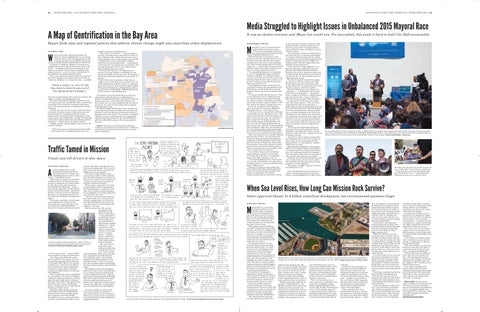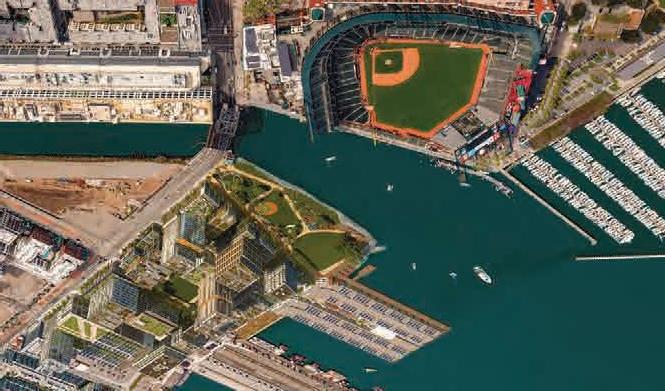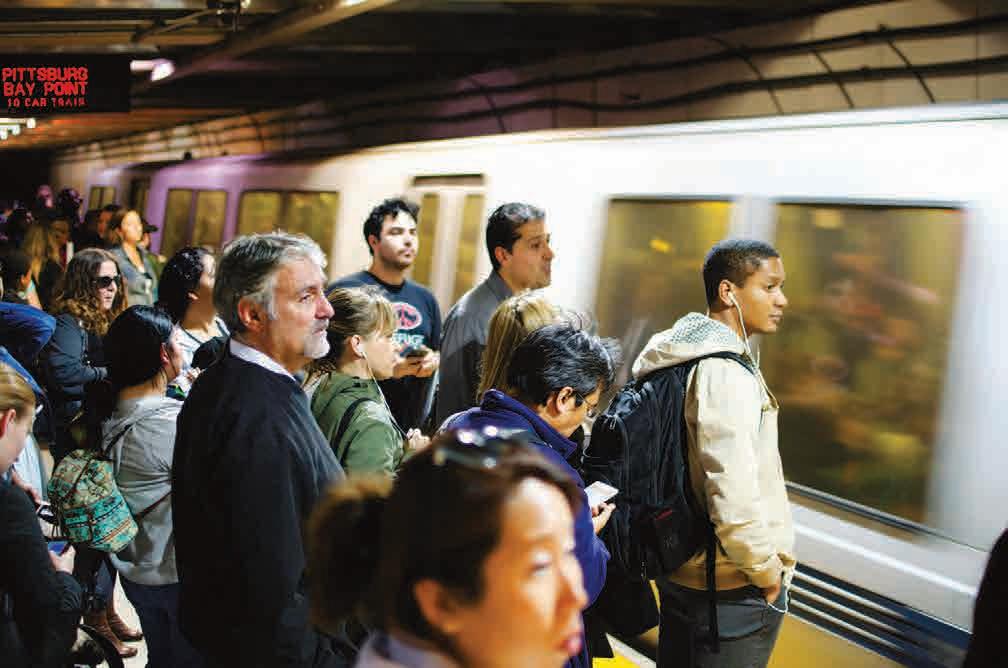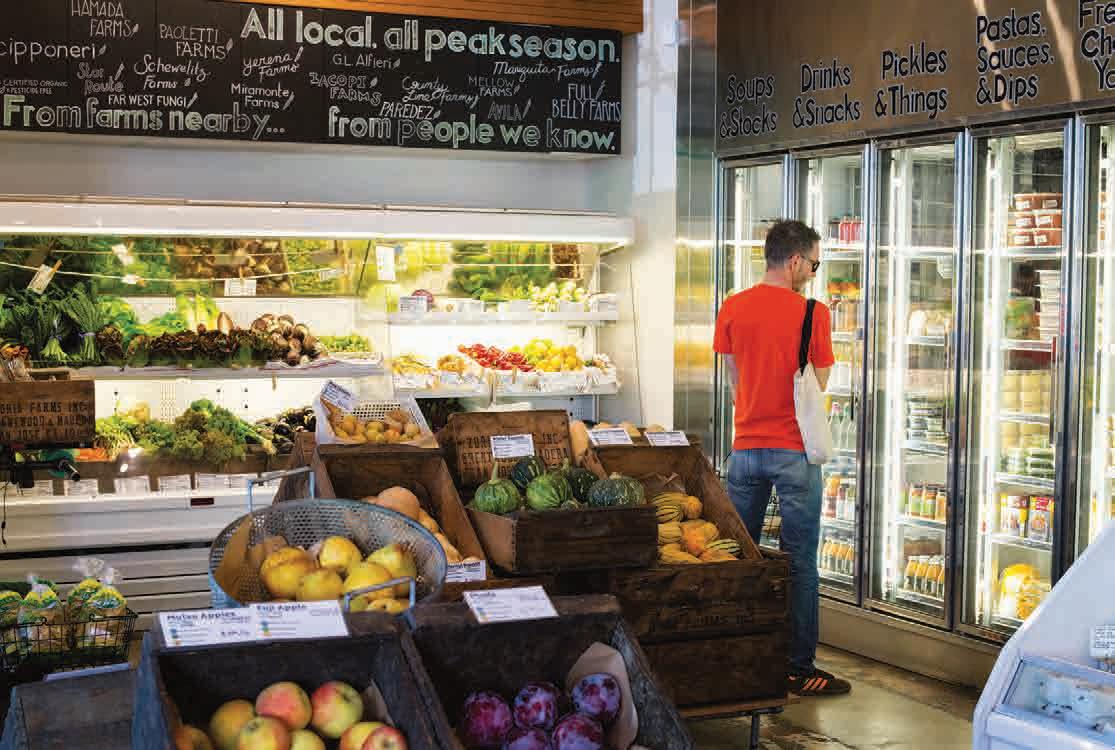A6 | SFPUBLICPRESS.ORG | SAN FRANCISCO PUBLIC PRESS, WINTER 2016
SAN FRANCISCO PUBLIC PRESS, WINTER 2016 | SFPUBLICPRESS.ORG | A3
Media Struggled to Highlight Issues in Unbalanced 2015 Mayoral Race
A Map of Gentrification in the Bay Area
It was an election everyone said Mayor Lee would win. For journalists, this made it hard to hold City Hall accountable.
Report finds state and regional policies that address climate change might also exacerbate urban displacement By Dan Brekke // KQED
W
here are the Bay Area’s gentrification hot spots? In which neighborhoods are low-income residents most at risk of being pushed out due to rising real estate prices? Which areas have become exclusive enclaves unattainable to most of us? University of California, Berkeley, researchers assembled data on more than 2,000 census tracts in the region — including everything from property prices and rents to density of low-income households to migration patterns — to try to create a new portrait of gentrification and displacement dynamics. The result, released in August under the auspices of the Urban Displacement Project at the University of California, Berkeley, is an interactive map — available
“There is simply no way for the Bay Area to build its way out of the displacement problem.” with lots of supplementary data and case studies at the project’s website, urbandisplacement.org. The team, led by Karen Chapple, a professor of city and regional planning, and Miriam Zuk, a postdoctoral researcher at the Center for Community Innovation, was not focusing specifically on displacement and gentrification. Instead, they were trying to answer questions about the impact of policies meant to help attain state and regional goals for responding to climate change — measures like encouraging infill development to help reduce sprawl and vehicle miles traveled. The takeaway is that those policies might spur gentrification and displacement — if they are not managed carefully. Chapple and Zuk said the biggest surprises from the research included:
• Fifty-three percent of all low-income households in the region live in neighborhoods at risk of, or
already experiencing, displacement.
• “The crisis is not half over” — meaning that ris-
ing rents and home prices, along with an influx of more affluent people, increase the pressure on lowincome people to move to the region’s outer suburbs. • Displacement is occurring beyond neighborhoods that are clearly gentrifying — something the researchers call “an ongoing story of exclusion” that is being experienced even in more affluent areas where property prices are rising. • Between 2000 and 2013, the region lost 50 percent of the units defined as affordable for lowincome households; at the same time, the number of low-income households regionwide increased by 10 percent. • One of their main conclusions is that there is simply no way for the Bay Area to build its way out of the displacement problem. Instead, an approach that focuses both on increasing the supply of affordable homes and adopting or strengthening policies to protect the existing supply of affordable housing will be needed to slow displacement. The project’s report also found that one of the key indicators for gentrification in a neighborhood is a spike in development of market-rate housing. That has become a key issue in San Francisco’s Mission District, which was one of nine neighborhoods the project focused on in a series of case studies that accompany the displacement map. We asked Chapple and Zuk about their thoughts on a proposed moratorium on market-rate housing in the Mission: Could it be effective in halting the march of gentrification in the district? Their answer: It might be useful as a tactic in winning some sort of agreement among community groups, the city and developers to add more affordable housing to the mix proposed for the area. KQED public radio serves the people of Northern California, broadcasting from Sacramento to Monterey, and publishing multimedia and interactive coverage online at kqed.org.
Traffic Tamed in Mission Visual cues tell drivers to slow down percent. Both before and after the measures were implemented, the city set up study of traffic data around tube counters across the road and sent Marshall Elementary declared staffers to count pedestrians. San Francisco’s first “home zone,” The last five-year collision report, established there in 2014 to calm measured from 2004 to 2009, indicates traffic, a resounding success. that 35 vehicle collisions occurred in the “This home zone project is a fantastic treated area. Thirty of those resulted in example of what can be achieved when an injury, three involved a pedestrian, streets are designed to be family-friendand three involved a bicyclist. ly. Not only was the most dangerous “Home zones” originated in the Nethdriving behavior addressed — speed — erlands and have been implemented in but walking, wheelchair rolling and bicythe United Kingdom, as well as in New cling to school skyrocketed,” said Nicole York City, as areas in which infrastrucFerrara, executive director of Walk San ture is designed to encourage pedestrian Francisco, in a statement issued by the use and safety, Jose said. San Francisco Municipal Transportation “You have visual cues that make you Agency. slow down while you’re driving, which The raised crosswalks, of which eight is really valuable when you’re driving were installed, force drivers to slow near Marshall Elementary or near an down when they mount and then cross area where there’s a lot of families and an intersection. Sidewalk bulbouts residents,” Jose said. shorten the distance pedestrians need to But the measures in this area go beyond the visual, physically forcing drivers to slow down. Using $300,000 of funding from Proposition K of 2003, the city installed three speed bumps, painted “edgelines” — which are painted on the street to narrow travel lanes to encourage drivers to reduce speeds — reduced lanes on 15th Street, added raised crosswalks and constructA newly installed raised crosswalk on Adair Street is a ed three bulbouts. visual and physical reminder for drivers to slow down. The city is also at San Francisco Municipal Transportation Agency photo work in the highcollision corridor that is South Van Ness Avenue. It has already travel to cross a street — three of them installed painted safety zones and limit were installed at Capp and 15th streets. lines, upgraded crosswalks between “Two things that made this a good 17th and 22nd streets, and installed place to pilot S.F.’s first home zone was pedestrian countdown signals at 21st documented speeding and documented and 22nd streets. In 2016, the agency cut-through traffic that we were seeing,” will add countdown signals along South said Ben Jose, a San Francisco MuniciVan Ness Avenue between 15th and 20th pal Transportation Agency spokesman, streets. referring to drivers who cut through For neighbors who notice dangerous residential neighborhoods to avoid main behaviors on their street and would like thoroughfares. to see similar measures implemented The transportation agency established in their neighborhoods, Jose suggested the zone partly as the result of frequent applying for calming measures. Though complaints about speeding cars and data this year’s round is closed, information that indicated a high rate of collisions. about the application process can be The zone, from 14th to 16th streets along found online: https://www.sfmta.com/serSouth Van Ness Avenue and Mission vices/streets-sidewalks. An application Street, includes portions of Capp, Minna, requires signatures from 20 neighbors. Natoma and Adair streets. Since the traffic-calming measures Founded in 2008 as a project of the were implemented, the transportation University of California, Berkeley’s agency has found that average speeds Journalism School, newly independent have dropped to less than 20 mph Mission Local aspires to be a model of lothroughout the area, people report feelcal, self-sustaining, fiercely independent ing safer and pedestrian traffic is up 20 neighborhood news.
By Laura Wenus // Mission Local
A
urbandisplacement.org
IN 2014, I ATTENDED THE INVESTIGATIVE REPORTERS AND EDITORS CONFERENCE AND LISTENED TO BEN POSTON OF THE LA TIMES GIVE A PANEL TALK ABOUT COMPSTAT.
HERE'S THE STORY ABOUT HOW I CAN'T TELL YOU THE STORY I WANT TO TELL YOU.
BEN POSTON
WRITTEN & DRAWN BY NEIL BALLARD COMPSTAT IS SHORT FOR 'COMPUTER STATISTICS.' IT'S A CRIME TRACKING SYSTEM USED BY MANY MAJOR POLICE DEPARMENTS, INCLUDING THE LAPD AND SFPD. IN SAN FRANCISCO, IT WORKS LIKE THIS:
ARRESTING OFFICER
COMMANDING OFFICER
RECORDS BUREAU OFFICER
AN OFFICER WRITES A REPORT AFTER RESPONDING TO AN INCIDENT, WITH A DESCRIPTION OF THE CRIME AND A BRIEF SUMMARY OF WHAT HAPPENED.
THAT REPORT IS SCANNED IN TO THE RECORDS BUREAU.
LET'S SAY A 'SIMPLE ASSUALT' REPORT CONTAINS A SUMMARY THAT DESCRIBES THE SUSPECT USING AN BOTTLE OR POOL CUE AS A WEAPON. ACCORDING TO THE PENAL CODE, THAT'S AN AGGRAVATED ASSAULT, WHICH IS A MORE SERIOUS CRIME.
THE LOCATIONS AND TYPES OF INCIDENTS ARE THEN USED TO GUIDE POLICING DECISIONS. IT'S AN EFFICIENT, DATA-DRIVEN APPROACH, BUT ONLY IF THERE IS ACCURATE DATA. AS IN ANY DATA SYSTEM, HUMAN ERROR MUST BE ACCOUNTED FOR, BUT WHAT ABOUT DELIBERATE MISINFORMATION? WHAT IF A DISTRICT CAPTAIN IS PRESSURED BY HIS/HER SUPERIORS TO KEEP PUBLIC NUMBERS DOWN FOR SERIOUS CRIMES?
LOS ANGELES IS NOT THE ONLY MUNICIPALITY WITH REPORTED COMPSTAT PROBLEMS, SO I FIGURED I'D AUDIT THE SFPD'S DATA. I GAVE POSTON A CALL.
UHH.. OFFICIAL
ACTUAL
BEN POSTON WAS PART OF AN LA TIMES INVESTIGATION THAT FOUND THE LAPD HAD DONE EXACTLY THAT ('LAPD MISCLASSIFIED NEARLY 1,200 VIOLENT CRIMES AS MINOR OFFENSES' LA TIMES, 8/9/14). HAD THE CRIMES BEEN CORRECTLY CLASSIFIED, THE VIOLENT CRIME TALLY THAT YEAR WOULD HAVE BEEN 7% HIGHER.
HE ADVISED ME TO REQUEST THREE MONTHS OF REPORTS RATHER THAN A YEAR'S WORTH, SO AS NOT TO SPOOK THE SFPD. I REQUESTED THE REPORTS UNDER SAN FRANCISCO'S SUNSHINE ORDINANCE.
AFTER MONTHS OF BACK AND FORTH EMAILS WITH PUBLIC INFORMATION OFFICER GRACE GATPANDAN, WHO WAS ALWAYS VERY RESPONSIVE AND COURTEOUS, I FINALLY GOT THE FIRST BATCH OF REPORTS.
GATPANDAN TOLD ME THAT THE REPORTS HAD TO BE PROCESSED, SENT TO INVESTIGATIONS, THEN SCANNED BEFORE THEY COULD BE SENT TO ME. MY REQUEST ENCOMPASSED 50,000+ REPORTS, AND THEY COULD BE SENT TO ME AT AN AVERAGE RATE OF TWENTY REPORTS PER WEEK. I HAD BEEN COMMUNICATING WITH OFFICER GATPANDAN SINCE JANUARY OF 2015. IN AUGUST, I ATTENDED A ROUNDTABLE INTERVIEW BETWEEN CHIEF GREG SUHR AND REPORTERS AND PUBLISHERS FROM SF NEIGHBORHOOD NEWSPAPERS. NATURALLY, I ASKED ABOUT MY RECORDS REQUEST. SUHR'S ANSWER WAS A SURPRISE.
I'M HAPPY TO WORK WITH YOU LATER IF YOU JUST WANT TO AUDIT REPORTS OF ALL ADULTS OR SOMETHING
CHIEF SUHR
HOLD ON, 50,000 REPORTS AT 20 PER WEEK WILL TAKE-
GATPANDAN CONFIRMED THIS TIMELINE. GIVEN THAT THE POPULATION OF SAN FRANCISCO IS QUITE SMALL RELATIVE TO OTHER MAJOR U.S. CITIES, IT DIDN'T MAKE SENSE THAT THIS STORY COULD BE DONE IN LOS ANGELES BUT NOT HERE.
HOWEVER, IT TURNED IF THERE'S A WAY TO STREAMLINE IT OUT NOT TO BE SO AND IF THERE'S SOMETHING IN EASY. IN FACT, I TRIED PARTICULAR THAT YOU WANT, THAT TWICE MORE TO WE CAN TRY TO MAYBE JUST GIVE CONTACT MEDIA TO YOU, IT WOULD BE A LOT EASIER RELATIONS TO OBTAIN THE REPORTS LIKE THE CHIEF SAID, AND I GOT THE SAME RESPONSE EACH TIME: REPORTS NEED TO BE PRINTED, SCANNED, SENT TO STATIONS/INVESTIGATIVE UNITS, REDACTED AND RE-SCANNED. IF ONLY THESE PUBLIC RECORDS COULD BE RECORDED IN A PUBLIC INFORMATION MANNER THAT FACILITATES EFFICIENT DISCLOSURE! OFFICER CARLOS MANFREDI
A version of this comic previously appeared in the Ingleside-Excelsior Light. Via San Francisco Neighborhood Newspaper Association
By Sara Bloomberg // Public Press
M
ayor Ed Lee won re-election this November without breaking a sweat. Five protest challengers stirred the race up but none had the political experience or financial backing to win. With limited time and resources, San Francisco reporters said they chose to focus on other races and ballot measures whose outcomes were less certain, such as Proposition I (the housing moratorium) or District 3 supervisor — a choice that left some reporters conflicted about journalism’s watchdog mandate in a largely unwatched election. “It's not good for democracy or our ability to cover it,” said Marisa Lagos, a political reporter for KQED. “As a political reporter you have to be realistic. You don’t want to not mention people who don’t have a chance and you have to balance that with the fact that they’re not going to win.” Tim Redmond, formerly of the San Francisco Bay Guardian and now publisher of 48 Hills Online, told the Public Press that he decided to devote his resources toward other issues. “It matters terribly who the mayor is. This is a bad situation we’re in,” Redmond said. It is good that there were protest challengers, “but as a realist, I think there are other issues that will have a greater impact” on the city, such as the District 3 supervisor’s race. In an Oct. 15 editorial, Jon Steinberg, editor-in-chief of San Francisco Magazine, decried the lack of a “real” mayor’s race. “Like Lee or not, an actual race would have been good for the city,” Steinberg wrote. “The mayor would have been forced to map out his plan for the next four years. He would have had to answer for the steady creep in evictions; for the scourge of homelessness; and, most of all, for the ongoing divide between the arriviste tech class and the fleeing middle class. Somebody might have even brought up the truly sketchy math underlying his promise to build 10,000 affordable units by 2020. Instead, he’s just coasting toward November.” This year’s mayoral race is starkly different from the last. In 2011, Lee won 60 percent of the vote after beating back 15 opponents, including a credible challenge from his left flank in the form of Supervisor John Avalos. This created a robust environment for political discourse in the media and around town. There were at least six mayoral debates that year. In 2015, there was only one. Clara Jeffery, editor-in-chief of Mother Jones magazine, sparked a conversation on Twitter about the lack of a competitive mayor’s race with this post on Oct. 26: “It is beyond appalling that a weak mayor of a city rife with problems and major driver of world economy is running essentially unopposed,” Jeffery wrote. Some San Franciscans speculated that local angel investor Ron Conway played an outsize role in discouraging would-be challengers. A week before the election, Pando.com published an email from Conway
to all of his “San Francisco-based SV Angel Portfolio CEOs” in which he asked them to share his personal list of election endorsements with their teams, including Lee as his choice for mayor. “The media this election is not focusing on the reason Ed Lee is running unchallenged; it is because of Ron Conway and his cohorts spending half a million dollars against David Campos” during last year’s assembly race, Redmond said, “and the climate of fear he’s imposed on local politicians.” In the absence of tough competitors, Lee did not seem eager to defend his record in the press. He snubbed the San Francisco Examiner this year by refusing to meet with its editorial board, according to an Examiner editorial on Oct. 15; the newspaper made no endorsement for mayor. The San Francisco Chronicle did endorse Lee, however, with this mild caveat: “MidMarket may be the best argument to both re-elect Mayor Ed Lee and demand more from the city’s cautious, conciliatory leader.” The Chronicle ran one story about Lee’s challengers — “5 challengers to S.F. mayor push grassroots democracy” — but did not name a single one of them in a follow-up piece about Lee’s first term: “5 years of Ed Lee: How has the city changed under the mayor?” In a pre-election interview, Lee asked a New York Times reporter: “Why isn’t there some big hitters who have experience in public office coming out and wanting to be the mayor of such a great city?” He answered his own rhetorical question by citing an overall rise in economic prosperity and a fall in the unemployment rate. Mark Leno, the former city supervisor and current state senator who demurred from running this year, disputed Lee’s rosy economic assessment of San Francisco, saying most of the new jobs have been taken by outsiders who have displaced city residents. The five protest challengers did garner some mainstream media attention; Stuart Schuffman, aka Broke-Ass Stuart, was featured in a video from AJ+, a digital service of Al Jazeera America. “For AJ+ the role of media covering political challengers who aren’t likely to win is to show what a protest campaign looks like,” Brooke Minters, a senior producer, told the Public Press by email. Beyond protest candidates, whose responsibility is it to hold the mayor accountable in a no-contest race? San Francisco journalists say a true reckoning should have emerged from the political class. But that may have to wait until the next mayoral race in 2019. Steinberg, of San Francisco Magazine, said Lee is “lucky that he doesn’t have to suffer the indignities of being questioned and challenged by a worthy opponent.” “He’s lucky,” he added, “but San Francisco most definitely is not.”
In the weeks before his easy re-election on Nov. 3, Mayor Ed Lee’s schedule was packed with public events, but many of them had nothing to do with politics. Lee and Salesforce CEO Marc Benioff (left) made a cameo appearance at a charity book drive hosted by Superintendent Richard Carranza (center) at Presidio Middle School in late August. Photos by Stella Sadikin // Public Press
Protesting the idea that Lee should consider the race a “cakewalk,” three of his five challengers — Francisco Herrera, Stuart Schuffman and Amy Farah Weiss, front — resorted to freshbaked performance art outside City Hall.
Note: Sara Bloomberg has freelanced as a reporter and photojournalist for numerous outlets, including KQED and 48 Hills Online.
When Sea Level Rises, How Long Can Mission Rock Survive? Voters approved Giants’ $1.6 billion waterfront development, but environmental questions linger By Kevin Stark // Public Press
M
ission Rock is a now lonely parking lot adjacent to San Francisco Bay, a tempting canvas for development in a city desperately in need of homes. But it is also a risky place to build because of a slow-moving but massive problem few politicians and business leaders are currently talking about: sea level rise. The expansive slab of landfill is one of the lowest-lying areas of Mission Bay, the 303-acre neighborhood that has been under construction for more than a decade in an area that experts say could be occasionally or permanently submerged as bay waters rise by many feet before the end of the 21st century. The project’s sponsor, the San Francisco Giants, won permission from the voters on Nov. 3 to move forward with a development plan, estimated to cost $1.6 billion, to build between 1,000 and 1,950 residential units, a new location for Anchor Brewing Co. and 8 acres of open space. It was the size of the buildings the Giants needed approval for. The plan is to blow past the otherwise maximum zoned height of 40 feet, soaring instead to 240. The developers say this helps the city by increasing housing density. But neither the language of Proposition D itself, nor the fusillade of campaign literature dropped on doorsteps around the city in support of the measure, talked about protection from rising sea levels. Most of the debate centered around housing, bay views and transportation. But water levels will certainly be an issue in a brand-new neighborhood that would require the city to install new plumbing, electricity and other infrastructure. The Giants said they had engineering and financial solutions to
Mission Rock, now a parking lot for sports fans, would become a dense residential and commercial neighborhood. Portions lie in a zone that could be threatened with flooding by the year 2100. Image courtesy of the San Francisco Giants address future flooding risk. The plan is to raise the grade of the land by several feet to postpone flooding due to sea level rise by several decades. Another part of the so-called adaptive management strategy would be to raise money through yearly neighborhood taxes to pay for costly protective fixes in the future. Would elevating the buildings be enough? In September 2014, city officials received a draft report they commissioned from outside environmental consultants that said the neighborhood would need to be protected from sea level rise either by a massive sea wall or re-engineered buildings. One suggestion was to
turn Third Street into a levee to protect most of Mission Bay. In this scenario the portion of the neighborhood between Third Street and the water, including Mission Rock, would utilize a series of floodable streets or canals to minimize water damage to structures. This is the second time in as many years that a proposition went to the ballot to approve a highdensity megadevelopment at the water’s edge. In 2014, San Francisco voters overwhelmingly approved a similar measure for a mixed-use development for the derelict industrial zone at Pier 70. Proposition F increased the height limit from 40
to 90 feet. Around the bay, developers are planning or currently building at least 27 major commercial and residential complexes on land that might be threatened by sea level rise by the end of this century. That land — roughly the area below 8 feet in elevation, which represents the high end of current predictions for permanent rise plus extreme storm surge, is estimated to be worth at least $21 billion. Cities around the Bay Area, including San Francisco, continue to issue dozens of permits for plans like these, even when they address future flood risks vaguely — if they
do at all. Experts in environmental planning say more regional coordination and legal changes would allow local governments to modify or even prevent new development that might necessitate expensive future solutions, such as creating even more extensive seawalls than are currently needed to protect existing bayside neighborhoods. A 2012 study of the effects of climate change on the West Coast, published by the National Research Council, found that average high tides will most likely be 3 feet higher permanently. While this amount of sea rise would put nearly all of the current shoreline at Mission Rock underwater, most computer models also have a statistically less probable but still possible upper range. Under several predictions, seas would rise about 4.6 feet by 2100. With 3.4 feet of additional surge in a “100-year storm,” the total rise would total 8 feet on a really bad day. It is hard to plan for sea level rise because the uncertainty in future global fossil fuel emissions makes global warming impossible to forecast perfectly. Climate researchers predict that sea level rise will only accelerate by the end of this century as ocean waters expand and glaciers melt. According to records from the San Francisco Planning Department, in the last five years the city has approved more that 50 projects that are below the 8-foot elevation zone, with estimated development costs of nearly $5 billion. Under the direction of Mayor Ed Lee, a new committee is coordinating a “high-level assessment” of risks and vulnerabilities, and could recommend stricter rules for future private development. City officials have said that any new regulation
should be written with a nuanced view of risk, determining more than simply whether a new building would flood, but also by the extent of the potential damage. In response to criticism in a report from a civil grand jury impaneled to review sea level rise policies, Lee has said it “may be unwise — and expensive — to require immediate measures to adapt to wide-ranging, highly uncertain sea-level rise projections further out in time.” But so far, sea level rise seems to register next to no mention in the public agenda or on the ballot itself as voters consider big changes to the waterfront. In the debate over Mission Rock, more immediate concerns carried the day, including how to alleviate the housing shortage. With some political arm-twisting, Supervisor Jane Kim was able to secure 40 percent of the new housing as “permanently affordable” — homes with rents set artificially lower than what the market will bear. After boosting that portion from an earlier pledge of 33 percent affordable, the baseball team won the support of all 11 members of the Board of Supervisors. Larry Baer, president of the Giants, told the San Francisco Chronicle that the team was responsive to the needs of the community. “We think we have a proposal that really speaks to the issues of the city today, in real time.” More online: For interactive maps, a review of the science and the story of how Bay Area planners and developers are grappling with a changing coastline, see the summer 2015 cover story, “Sea Level Rise Threatens Waterfront Development.” sfpublicpress.org/searise




